COIT20249 Report: 3D Printing Tech for Business Expansion in Oceania
VerifiedAdded on 2023/06/13
|13
|4010
|402
Report
AI Summary
This report investigates the potential of 3D printing technology for a medium-sized ICT manufacturing company based in Melbourne, Australia, seeking to expand its business to other regions in Australia and Oceania. The report defines 3D printing technology, discusses various applications in manufacturing, medical, and industrial sectors, and explores how the company can leverage these applications, particularly in computers and robotics, food production, and bio-printing, to facilitate its expansion. It also addresses the advantages and disadvantages of adopting 3D printing, alongside legal, social, and ethical considerations. The research methodology employed is secondary research, utilizing available data to analyze the feasibility and effectiveness of 3D printing for the company's growth objectives, culminating in recommendations for implementation.
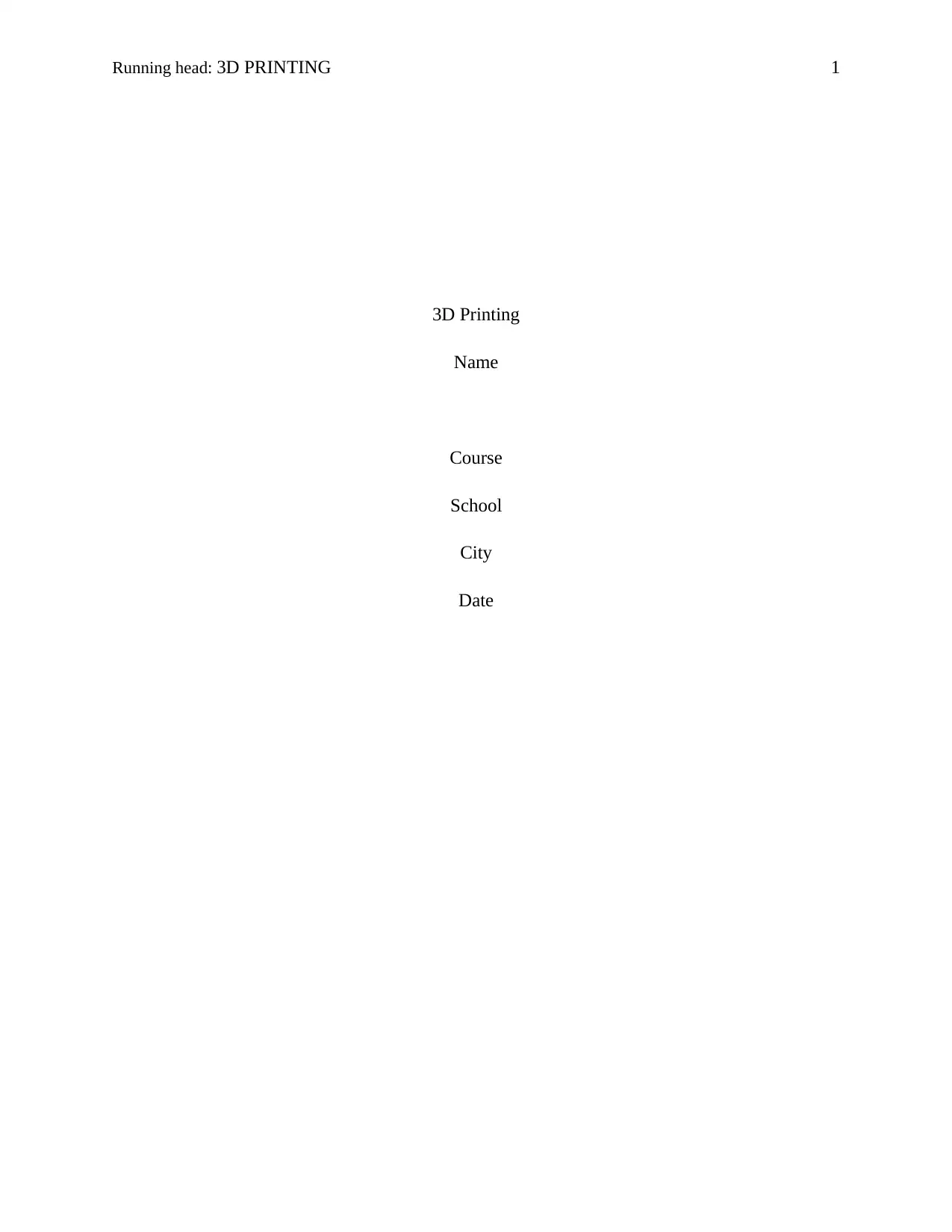
Running head: 3D PRINTING 1
3D Printing
Name
Course
School
City
Date
3D Printing
Name
Course
School
City
Date
Paraphrase This Document
Need a fresh take? Get an instant paraphrase of this document with our AI Paraphraser
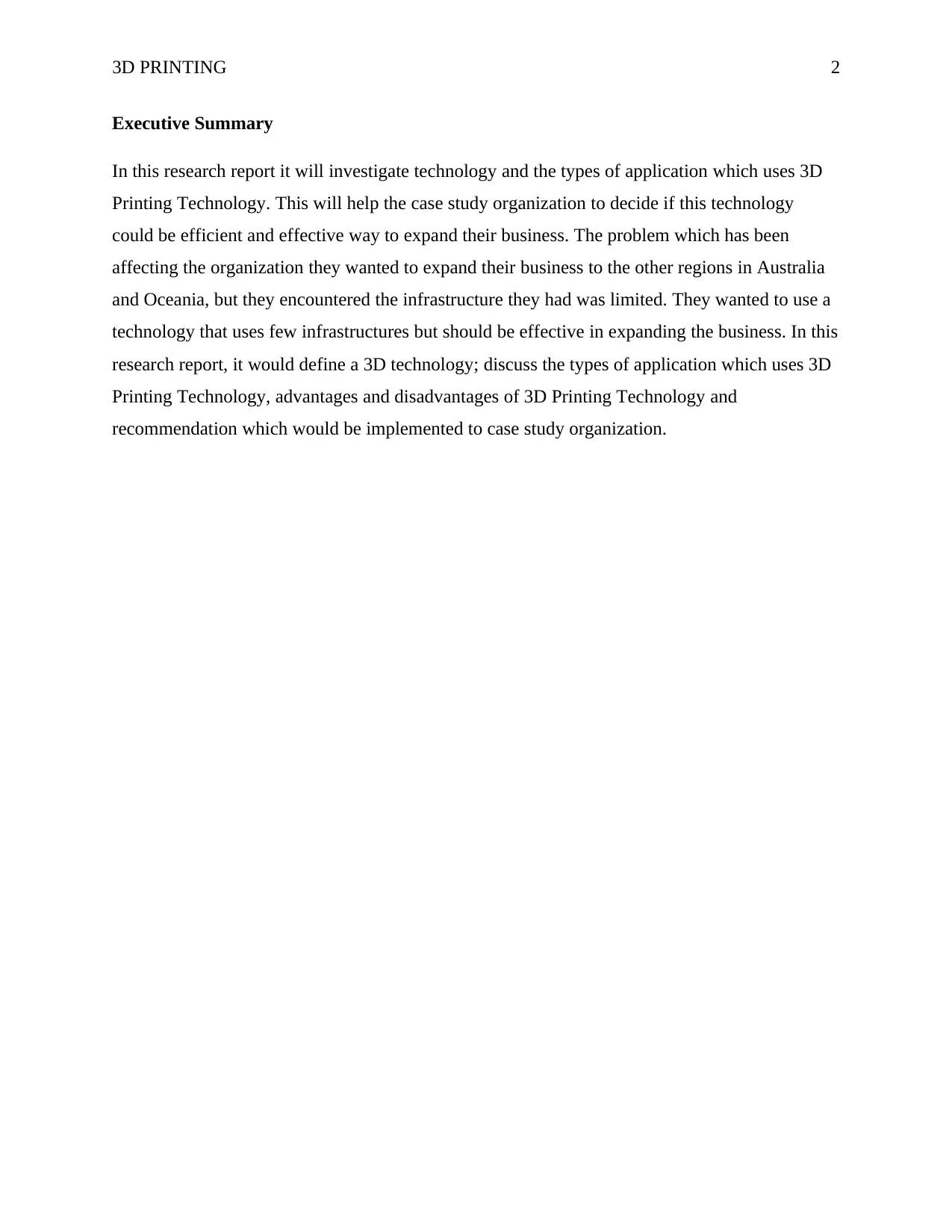
3D PRINTING 2
Executive Summary
In this research report it will investigate technology and the types of application which uses 3D
Printing Technology. This will help the case study organization to decide if this technology
could be efficient and effective way to expand their business. The problem which has been
affecting the organization they wanted to expand their business to the other regions in Australia
and Oceania, but they encountered the infrastructure they had was limited. They wanted to use a
technology that uses few infrastructures but should be effective in expanding the business. In this
research report, it would define a 3D technology; discuss the types of application which uses 3D
Printing Technology, advantages and disadvantages of 3D Printing Technology and
recommendation which would be implemented to case study organization.
Executive Summary
In this research report it will investigate technology and the types of application which uses 3D
Printing Technology. This will help the case study organization to decide if this technology
could be efficient and effective way to expand their business. The problem which has been
affecting the organization they wanted to expand their business to the other regions in Australia
and Oceania, but they encountered the infrastructure they had was limited. They wanted to use a
technology that uses few infrastructures but should be effective in expanding the business. In this
research report, it would define a 3D technology; discuss the types of application which uses 3D
Printing Technology, advantages and disadvantages of 3D Printing Technology and
recommendation which would be implemented to case study organization.
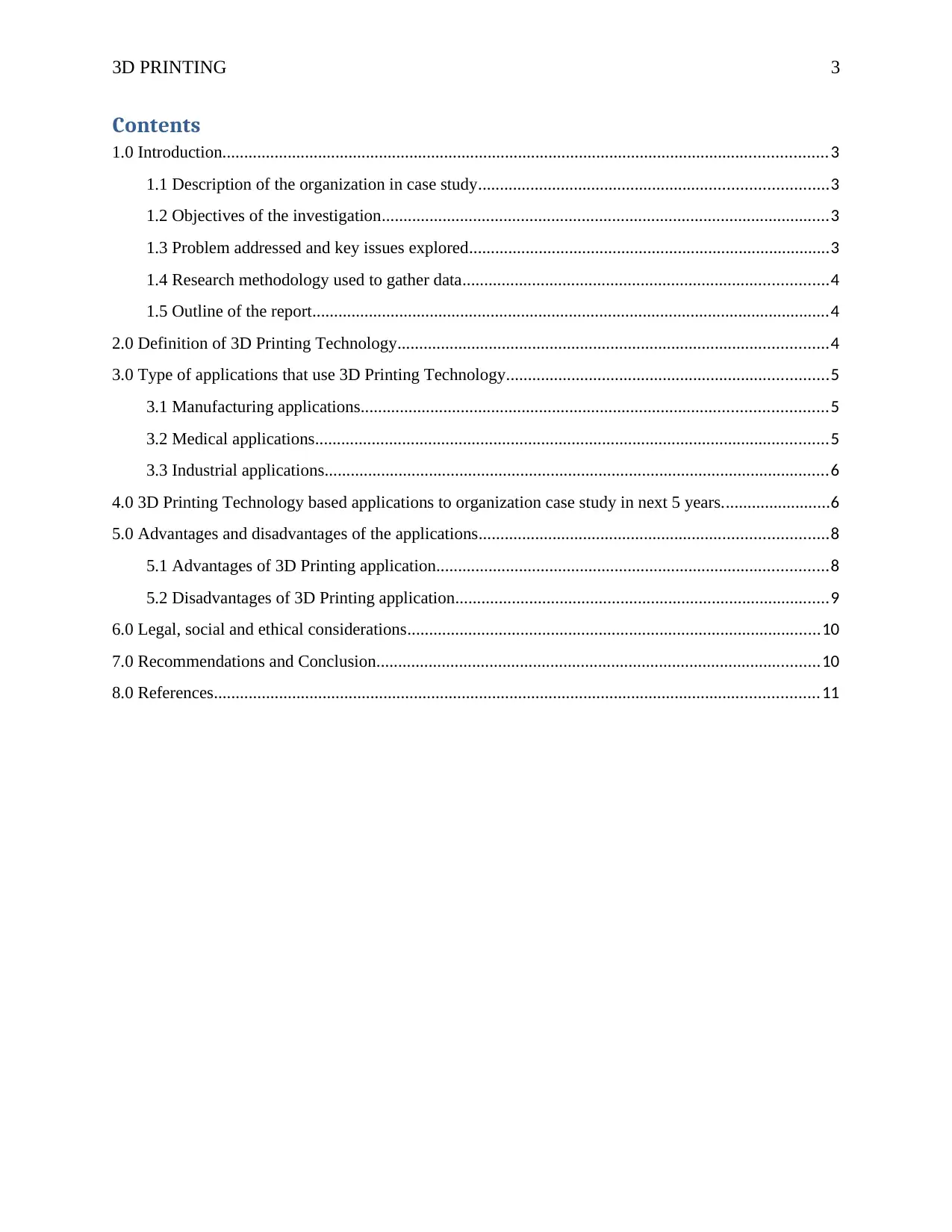
3D PRINTING 3
Contents
1.0 Introduction...........................................................................................................................................3
1.1 Description of the organization in case study................................................................................3
1.2 Objectives of the investigation.......................................................................................................3
1.3 Problem addressed and key issues explored...................................................................................3
1.4 Research methodology used to gather data....................................................................................4
1.5 Outline of the report.......................................................................................................................4
2.0 Definition of 3D Printing Technology...................................................................................................4
3.0 Type of applications that use 3D Printing Technology..........................................................................5
3.1 Manufacturing applications...........................................................................................................5
3.2 Medical applications......................................................................................................................5
3.3 Industrial applications....................................................................................................................6
4.0 3D Printing Technology based applications to organization case study in next 5 years.........................6
5.0 Advantages and disadvantages of the applications................................................................................8
5.1 Advantages of 3D Printing application..........................................................................................8
5.2 Disadvantages of 3D Printing application......................................................................................9
6.0 Legal, social and ethical considerations...............................................................................................10
7.0 Recommendations and Conclusion......................................................................................................10
8.0 References...........................................................................................................................................11
Contents
1.0 Introduction...........................................................................................................................................3
1.1 Description of the organization in case study................................................................................3
1.2 Objectives of the investigation.......................................................................................................3
1.3 Problem addressed and key issues explored...................................................................................3
1.4 Research methodology used to gather data....................................................................................4
1.5 Outline of the report.......................................................................................................................4
2.0 Definition of 3D Printing Technology...................................................................................................4
3.0 Type of applications that use 3D Printing Technology..........................................................................5
3.1 Manufacturing applications...........................................................................................................5
3.2 Medical applications......................................................................................................................5
3.3 Industrial applications....................................................................................................................6
4.0 3D Printing Technology based applications to organization case study in next 5 years.........................6
5.0 Advantages and disadvantages of the applications................................................................................8
5.1 Advantages of 3D Printing application..........................................................................................8
5.2 Disadvantages of 3D Printing application......................................................................................9
6.0 Legal, social and ethical considerations...............................................................................................10
7.0 Recommendations and Conclusion......................................................................................................10
8.0 References...........................................................................................................................................11
⊘ This is a preview!⊘
Do you want full access?
Subscribe today to unlock all pages.

Trusted by 1+ million students worldwide

3D PRINTING 4
1.0 Introduction
In this report, it is about 3D Printing technology and it numerous uses especially in the
manufacturing (Calì, CalianAmati, Kleinberger, Steed, Kautz & Weyrich, 2012). The reports aim
to investigate on this technology and the type of applications which uses 3D Printing technology
with the prospect to decide if the technology could be efficient and an effective way to expand
the business for organization in this case study.
1.1 Description of the organization in case study
The organization for this case study is an ICT medium sized manufacturing which was stated ten
years ago which is based in the industrial suburb of Melbourne in Victoria (Calì, CalianAmati,
Kleinberger, Steed, Kautz & Weyrich, 2012). The organization has retail and corporate client as
well as numerous retail branches which are within Victoria. The organization is involved in the
manufacture of the computers as well as the printers for the businesses which are within Victoria.
The organization of recent wants to explore on the options to expand on their business to the
coming 5 years to some of the other states in Australia as well as to Oceania region and expand
to their online activities.
1.2 Objectives of the investigation
The objective of this research is to investigate on the prospect to decide if 3D Printing
Technology could be efficient as well as effective means of expanding the business in this case
study (Calì, CalianAmati, Kleinberger, Steed, Kautz & Weyrich, 2012). The aim is to assist the
organization to decide on the best 3D Printing Technology to decide on the best technology that
would be efficient to this business.
1.3 Problem addressed and key issues explored
The organization has started to migrate into the online business operations and they want to
expand their business to the other region in Australia the issue they want to address is to expand
without the need to create large amount of infrastructure to the other locations both in Australia
and Oceania regions (Campbell, Williams, Ivanova & Garrett, 2011). As they do so they want to
address the issue of security, authentication as well as other technological issues which they
could encounter as they expand. As the Head of the ICT in this organization the task is to explore
on this technology and the types of the application which uses 3D Printing Technology which
has been a disruptive technology since it has grown astronomically and it has potential to change
on the way business is carried out (Campbell, Williams, Ivanova & Garrett, 2011)..
1.0 Introduction
In this report, it is about 3D Printing technology and it numerous uses especially in the
manufacturing (Calì, CalianAmati, Kleinberger, Steed, Kautz & Weyrich, 2012). The reports aim
to investigate on this technology and the type of applications which uses 3D Printing technology
with the prospect to decide if the technology could be efficient and an effective way to expand
the business for organization in this case study.
1.1 Description of the organization in case study
The organization for this case study is an ICT medium sized manufacturing which was stated ten
years ago which is based in the industrial suburb of Melbourne in Victoria (Calì, CalianAmati,
Kleinberger, Steed, Kautz & Weyrich, 2012). The organization has retail and corporate client as
well as numerous retail branches which are within Victoria. The organization is involved in the
manufacture of the computers as well as the printers for the businesses which are within Victoria.
The organization of recent wants to explore on the options to expand on their business to the
coming 5 years to some of the other states in Australia as well as to Oceania region and expand
to their online activities.
1.2 Objectives of the investigation
The objective of this research is to investigate on the prospect to decide if 3D Printing
Technology could be efficient as well as effective means of expanding the business in this case
study (Calì, CalianAmati, Kleinberger, Steed, Kautz & Weyrich, 2012). The aim is to assist the
organization to decide on the best 3D Printing Technology to decide on the best technology that
would be efficient to this business.
1.3 Problem addressed and key issues explored
The organization has started to migrate into the online business operations and they want to
expand their business to the other region in Australia the issue they want to address is to expand
without the need to create large amount of infrastructure to the other locations both in Australia
and Oceania regions (Campbell, Williams, Ivanova & Garrett, 2011). As they do so they want to
address the issue of security, authentication as well as other technological issues which they
could encounter as they expand. As the Head of the ICT in this organization the task is to explore
on this technology and the types of the application which uses 3D Printing Technology which
has been a disruptive technology since it has grown astronomically and it has potential to change
on the way business is carried out (Campbell, Williams, Ivanova & Garrett, 2011)..
Paraphrase This Document
Need a fresh take? Get an instant paraphrase of this document with our AI Paraphraser
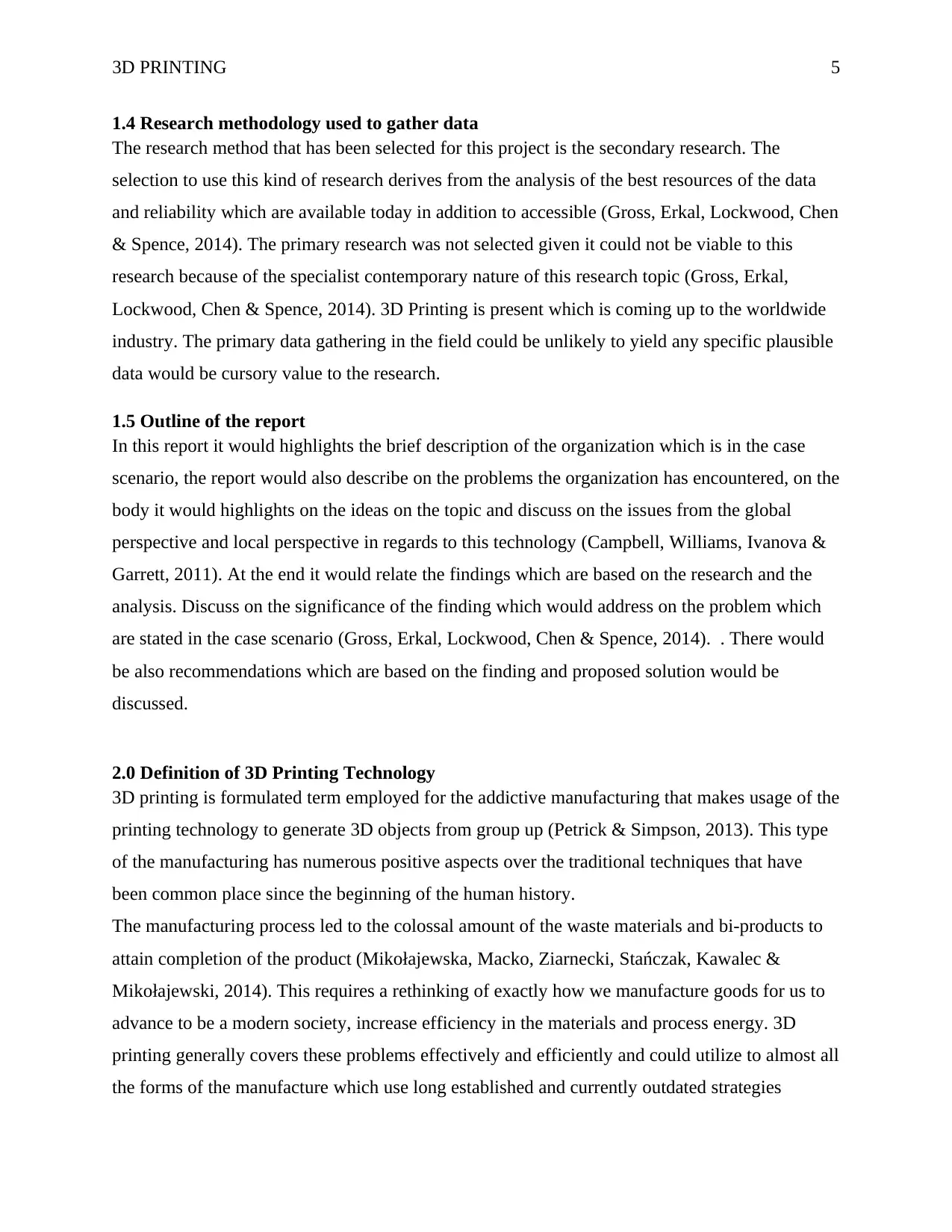
3D PRINTING 5
1.4 Research methodology used to gather data
The research method that has been selected for this project is the secondary research. The
selection to use this kind of research derives from the analysis of the best resources of the data
and reliability which are available today in addition to accessible (Gross, Erkal, Lockwood, Chen
& Spence, 2014). The primary research was not selected given it could not be viable to this
research because of the specialist contemporary nature of this research topic (Gross, Erkal,
Lockwood, Chen & Spence, 2014). 3D Printing is present which is coming up to the worldwide
industry. The primary data gathering in the field could be unlikely to yield any specific plausible
data would be cursory value to the research.
1.5 Outline of the report
In this report it would highlights the brief description of the organization which is in the case
scenario, the report would also describe on the problems the organization has encountered, on the
body it would highlights on the ideas on the topic and discuss on the issues from the global
perspective and local perspective in regards to this technology (Campbell, Williams, Ivanova &
Garrett, 2011). At the end it would relate the findings which are based on the research and the
analysis. Discuss on the significance of the finding which would address on the problem which
are stated in the case scenario (Gross, Erkal, Lockwood, Chen & Spence, 2014). . There would
be also recommendations which are based on the finding and proposed solution would be
discussed.
2.0 Definition of 3D Printing Technology
3D printing is formulated term employed for the addictive manufacturing that makes usage of the
printing technology to generate 3D objects from group up (Petrick & Simpson, 2013). This type
of the manufacturing has numerous positive aspects over the traditional techniques that have
been common place since the beginning of the human history.
The manufacturing process led to the colossal amount of the waste materials and bi-products to
attain completion of the product (Mikołajewska, Macko, Ziarnecki, Stańczak, Kawalec &
Mikołajewski, 2014). This requires a rethinking of exactly how we manufacture goods for us to
advance to be a modern society, increase efficiency in the materials and process energy. 3D
printing generally covers these problems effectively and efficiently and could utilize to almost all
the forms of the manufacture which use long established and currently outdated strategies
1.4 Research methodology used to gather data
The research method that has been selected for this project is the secondary research. The
selection to use this kind of research derives from the analysis of the best resources of the data
and reliability which are available today in addition to accessible (Gross, Erkal, Lockwood, Chen
& Spence, 2014). The primary research was not selected given it could not be viable to this
research because of the specialist contemporary nature of this research topic (Gross, Erkal,
Lockwood, Chen & Spence, 2014). 3D Printing is present which is coming up to the worldwide
industry. The primary data gathering in the field could be unlikely to yield any specific plausible
data would be cursory value to the research.
1.5 Outline of the report
In this report it would highlights the brief description of the organization which is in the case
scenario, the report would also describe on the problems the organization has encountered, on the
body it would highlights on the ideas on the topic and discuss on the issues from the global
perspective and local perspective in regards to this technology (Campbell, Williams, Ivanova &
Garrett, 2011). At the end it would relate the findings which are based on the research and the
analysis. Discuss on the significance of the finding which would address on the problem which
are stated in the case scenario (Gross, Erkal, Lockwood, Chen & Spence, 2014). . There would
be also recommendations which are based on the finding and proposed solution would be
discussed.
2.0 Definition of 3D Printing Technology
3D printing is formulated term employed for the addictive manufacturing that makes usage of the
printing technology to generate 3D objects from group up (Petrick & Simpson, 2013). This type
of the manufacturing has numerous positive aspects over the traditional techniques that have
been common place since the beginning of the human history.
The manufacturing process led to the colossal amount of the waste materials and bi-products to
attain completion of the product (Mikołajewska, Macko, Ziarnecki, Stańczak, Kawalec &
Mikołajewski, 2014). This requires a rethinking of exactly how we manufacture goods for us to
advance to be a modern society, increase efficiency in the materials and process energy. 3D
printing generally covers these problems effectively and efficiently and could utilize to almost all
the forms of the manufacture which use long established and currently outdated strategies
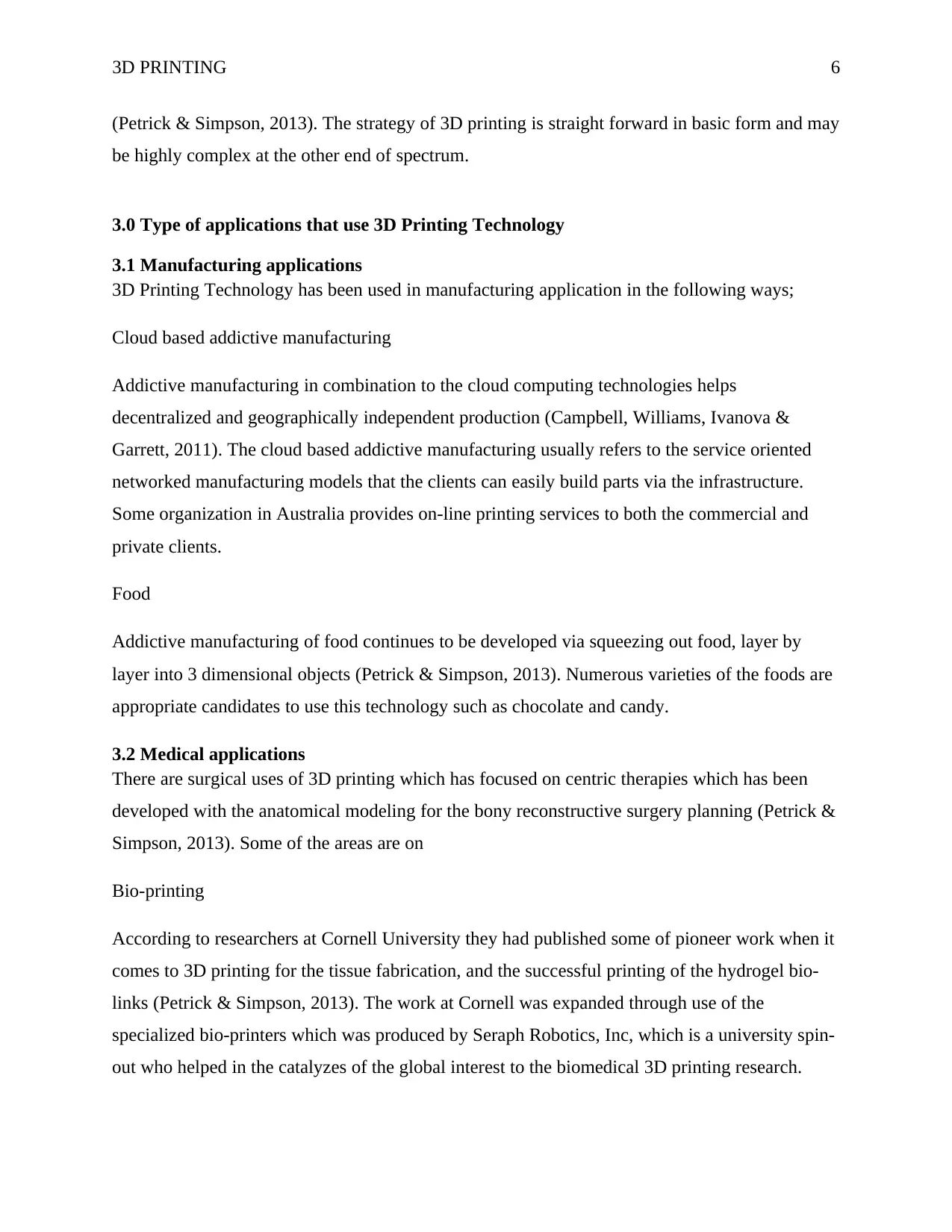
3D PRINTING 6
(Petrick & Simpson, 2013). The strategy of 3D printing is straight forward in basic form and may
be highly complex at the other end of spectrum.
3.0 Type of applications that use 3D Printing Technology
3.1 Manufacturing applications
3D Printing Technology has been used in manufacturing application in the following ways;
Cloud based addictive manufacturing
Addictive manufacturing in combination to the cloud computing technologies helps
decentralized and geographically independent production (Campbell, Williams, Ivanova &
Garrett, 2011). The cloud based addictive manufacturing usually refers to the service oriented
networked manufacturing models that the clients can easily build parts via the infrastructure.
Some organization in Australia provides on-line printing services to both the commercial and
private clients.
Food
Addictive manufacturing of food continues to be developed via squeezing out food, layer by
layer into 3 dimensional objects (Petrick & Simpson, 2013). Numerous varieties of the foods are
appropriate candidates to use this technology such as chocolate and candy.
3.2 Medical applications
There are surgical uses of 3D printing which has focused on centric therapies which has been
developed with the anatomical modeling for the bony reconstructive surgery planning (Petrick &
Simpson, 2013). Some of the areas are on
Bio-printing
According to researchers at Cornell University they had published some of pioneer work when it
comes to 3D printing for the tissue fabrication, and the successful printing of the hydrogel bio-
links (Petrick & Simpson, 2013). The work at Cornell was expanded through use of the
specialized bio-printers which was produced by Seraph Robotics, Inc, which is a university spin-
out who helped in the catalyzes of the global interest to the biomedical 3D printing research.
(Petrick & Simpson, 2013). The strategy of 3D printing is straight forward in basic form and may
be highly complex at the other end of spectrum.
3.0 Type of applications that use 3D Printing Technology
3.1 Manufacturing applications
3D Printing Technology has been used in manufacturing application in the following ways;
Cloud based addictive manufacturing
Addictive manufacturing in combination to the cloud computing technologies helps
decentralized and geographically independent production (Campbell, Williams, Ivanova &
Garrett, 2011). The cloud based addictive manufacturing usually refers to the service oriented
networked manufacturing models that the clients can easily build parts via the infrastructure.
Some organization in Australia provides on-line printing services to both the commercial and
private clients.
Food
Addictive manufacturing of food continues to be developed via squeezing out food, layer by
layer into 3 dimensional objects (Petrick & Simpson, 2013). Numerous varieties of the foods are
appropriate candidates to use this technology such as chocolate and candy.
3.2 Medical applications
There are surgical uses of 3D printing which has focused on centric therapies which has been
developed with the anatomical modeling for the bony reconstructive surgery planning (Petrick &
Simpson, 2013). Some of the areas are on
Bio-printing
According to researchers at Cornell University they had published some of pioneer work when it
comes to 3D printing for the tissue fabrication, and the successful printing of the hydrogel bio-
links (Petrick & Simpson, 2013). The work at Cornell was expanded through use of the
specialized bio-printers which was produced by Seraph Robotics, Inc, which is a university spin-
out who helped in the catalyzes of the global interest to the biomedical 3D printing research.
⊘ This is a preview!⊘
Do you want full access?
Subscribe today to unlock all pages.

Trusted by 1+ million students worldwide
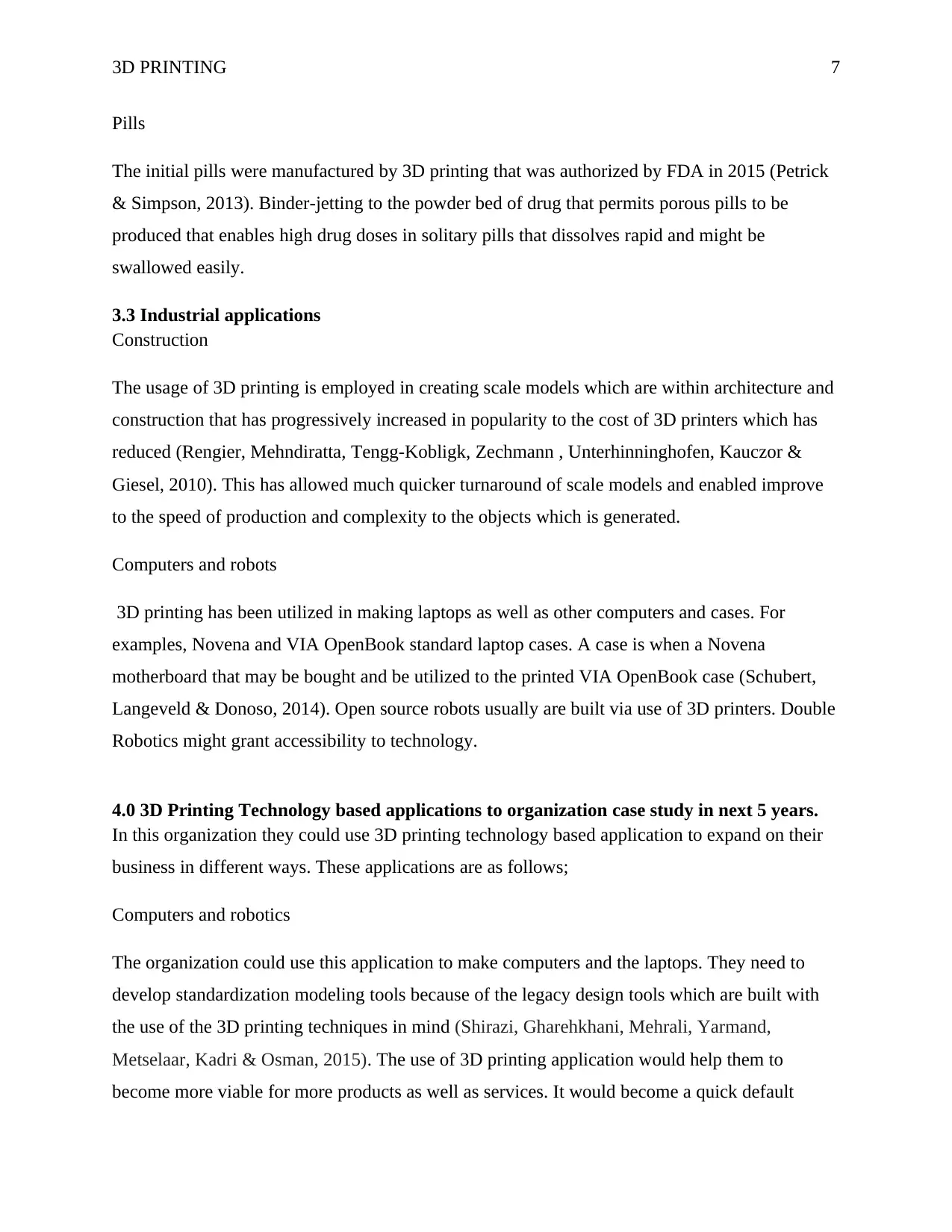
3D PRINTING 7
Pills
The initial pills were manufactured by 3D printing that was authorized by FDA in 2015 (Petrick
& Simpson, 2013). Binder-jetting to the powder bed of drug that permits porous pills to be
produced that enables high drug doses in solitary pills that dissolves rapid and might be
swallowed easily.
3.3 Industrial applications
Construction
The usage of 3D printing is employed in creating scale models which are within architecture and
construction that has progressively increased in popularity to the cost of 3D printers which has
reduced (Rengier, Mehndiratta, Tengg-Kobligk, Zechmann , Unterhinninghofen, Kauczor &
Giesel, 2010). This has allowed much quicker turnaround of scale models and enabled improve
to the speed of production and complexity to the objects which is generated.
Computers and robots
3D printing has been utilized in making laptops as well as other computers and cases. For
examples, Novena and VIA OpenBook standard laptop cases. A case is when a Novena
motherboard that may be bought and be utilized to the printed VIA OpenBook case (Schubert,
Langeveld & Donoso, 2014). Open source robots usually are built via use of 3D printers. Double
Robotics might grant accessibility to technology.
4.0 3D Printing Technology based applications to organization case study in next 5 years.
In this organization they could use 3D printing technology based application to expand on their
business in different ways. These applications are as follows;
Computers and robotics
The organization could use this application to make computers and the laptops. They need to
develop standardization modeling tools because of the legacy design tools which are built with
the use of the 3D printing techniques in mind (Shirazi, Gharehkhani, Mehrali, Yarmand,
Metselaar, Kadri & Osman, 2015). The use of 3D printing application would help them to
become more viable for more products as well as services. It would become a quick default
Pills
The initial pills were manufactured by 3D printing that was authorized by FDA in 2015 (Petrick
& Simpson, 2013). Binder-jetting to the powder bed of drug that permits porous pills to be
produced that enables high drug doses in solitary pills that dissolves rapid and might be
swallowed easily.
3.3 Industrial applications
Construction
The usage of 3D printing is employed in creating scale models which are within architecture and
construction that has progressively increased in popularity to the cost of 3D printers which has
reduced (Rengier, Mehndiratta, Tengg-Kobligk, Zechmann , Unterhinninghofen, Kauczor &
Giesel, 2010). This has allowed much quicker turnaround of scale models and enabled improve
to the speed of production and complexity to the objects which is generated.
Computers and robots
3D printing has been utilized in making laptops as well as other computers and cases. For
examples, Novena and VIA OpenBook standard laptop cases. A case is when a Novena
motherboard that may be bought and be utilized to the printed VIA OpenBook case (Schubert,
Langeveld & Donoso, 2014). Open source robots usually are built via use of 3D printers. Double
Robotics might grant accessibility to technology.
4.0 3D Printing Technology based applications to organization case study in next 5 years.
In this organization they could use 3D printing technology based application to expand on their
business in different ways. These applications are as follows;
Computers and robotics
The organization could use this application to make computers and the laptops. They need to
develop standardization modeling tools because of the legacy design tools which are built with
the use of the 3D printing techniques in mind (Shirazi, Gharehkhani, Mehrali, Yarmand,
Metselaar, Kadri & Osman, 2015). The use of 3D printing application would help them to
become more viable for more products as well as services. It would become a quick default
Paraphrase This Document
Need a fresh take? Get an instant paraphrase of this document with our AI Paraphraser
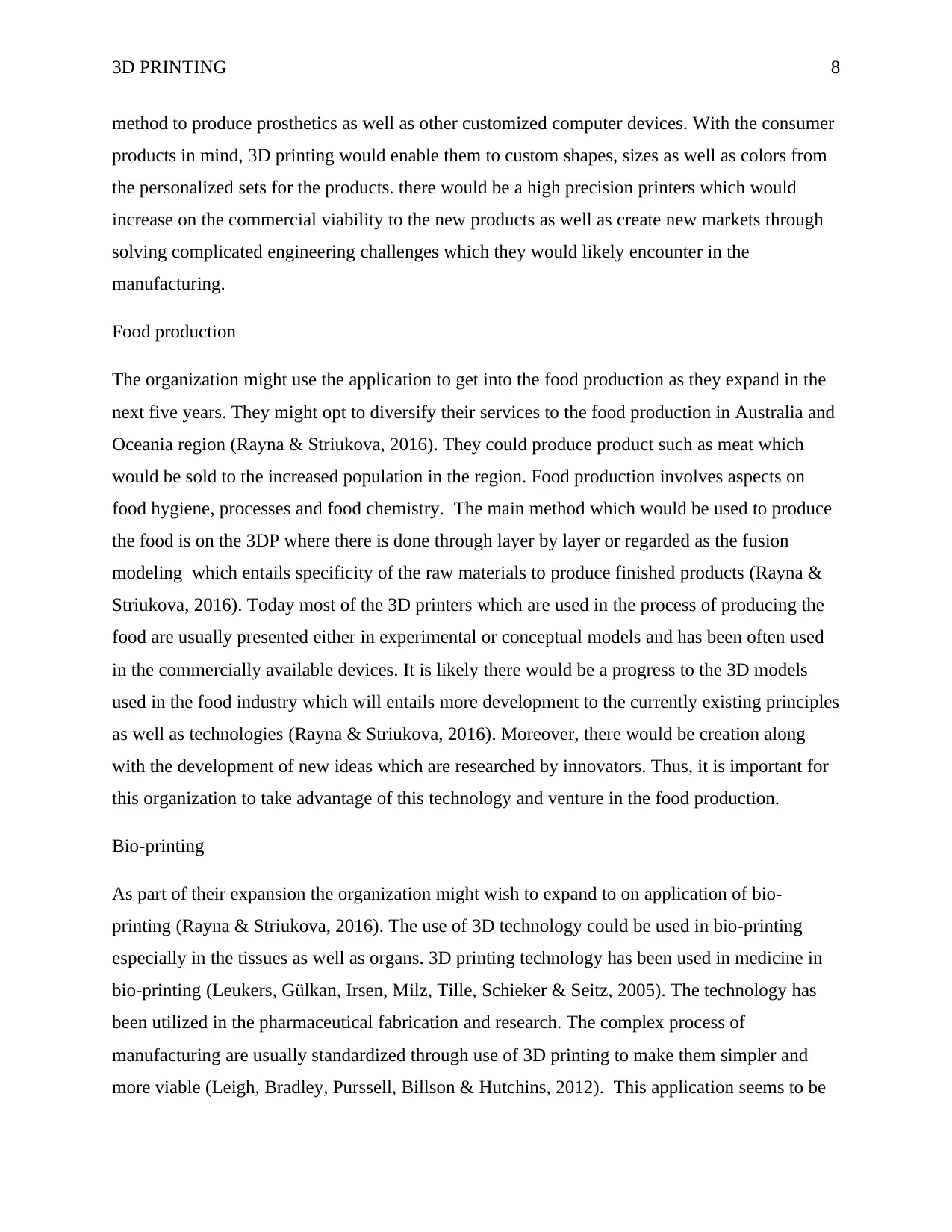
3D PRINTING 8
method to produce prosthetics as well as other customized computer devices. With the consumer
products in mind, 3D printing would enable them to custom shapes, sizes as well as colors from
the personalized sets for the products. there would be a high precision printers which would
increase on the commercial viability to the new products as well as create new markets through
solving complicated engineering challenges which they would likely encounter in the
manufacturing.
Food production
The organization might use the application to get into the food production as they expand in the
next five years. They might opt to diversify their services to the food production in Australia and
Oceania region (Rayna & Striukova, 2016). They could produce product such as meat which
would be sold to the increased population in the region. Food production involves aspects on
food hygiene, processes and food chemistry. The main method which would be used to produce
the food is on the 3DP where there is done through layer by layer or regarded as the fusion
modeling which entails specificity of the raw materials to produce finished products (Rayna &
Striukova, 2016). Today most of the 3D printers which are used in the process of producing the
food are usually presented either in experimental or conceptual models and has been often used
in the commercially available devices. It is likely there would be a progress to the 3D models
used in the food industry which will entails more development to the currently existing principles
as well as technologies (Rayna & Striukova, 2016). Moreover, there would be creation along
with the development of new ideas which are researched by innovators. Thus, it is important for
this organization to take advantage of this technology and venture in the food production.
Bio-printing
As part of their expansion the organization might wish to expand to on application of bio-
printing (Rayna & Striukova, 2016). The use of 3D technology could be used in bio-printing
especially in the tissues as well as organs. 3D printing technology has been used in medicine in
bio-printing (Leukers, Gülkan, Irsen, Milz, Tille, Schieker & Seitz, 2005). The technology has
been utilized in the pharmaceutical fabrication and research. The complex process of
manufacturing are usually standardized through use of 3D printing to make them simpler and
more viable (Leigh, Bradley, Purssell, Billson & Hutchins, 2012). This application seems to be
method to produce prosthetics as well as other customized computer devices. With the consumer
products in mind, 3D printing would enable them to custom shapes, sizes as well as colors from
the personalized sets for the products. there would be a high precision printers which would
increase on the commercial viability to the new products as well as create new markets through
solving complicated engineering challenges which they would likely encounter in the
manufacturing.
Food production
The organization might use the application to get into the food production as they expand in the
next five years. They might opt to diversify their services to the food production in Australia and
Oceania region (Rayna & Striukova, 2016). They could produce product such as meat which
would be sold to the increased population in the region. Food production involves aspects on
food hygiene, processes and food chemistry. The main method which would be used to produce
the food is on the 3DP where there is done through layer by layer or regarded as the fusion
modeling which entails specificity of the raw materials to produce finished products (Rayna &
Striukova, 2016). Today most of the 3D printers which are used in the process of producing the
food are usually presented either in experimental or conceptual models and has been often used
in the commercially available devices. It is likely there would be a progress to the 3D models
used in the food industry which will entails more development to the currently existing principles
as well as technologies (Rayna & Striukova, 2016). Moreover, there would be creation along
with the development of new ideas which are researched by innovators. Thus, it is important for
this organization to take advantage of this technology and venture in the food production.
Bio-printing
As part of their expansion the organization might wish to expand to on application of bio-
printing (Rayna & Striukova, 2016). The use of 3D technology could be used in bio-printing
especially in the tissues as well as organs. 3D printing technology has been used in medicine in
bio-printing (Leukers, Gülkan, Irsen, Milz, Tille, Schieker & Seitz, 2005). The technology has
been utilized in the pharmaceutical fabrication and research. The complex process of
manufacturing are usually standardized through use of 3D printing to make them simpler and
more viable (Leigh, Bradley, Purssell, Billson & Hutchins, 2012). This application seems to be

3D PRINTING 9
promising since it is transformative and suitable. The technology has been adopted to the
production of the personalized medicine dosages as well as development of the unique drugs
forms (Leigh, Bradley, Purssell, Billson & Hutchins, 2012). It has been utilized in development
to more reliable medical devices which is part of the customized as well as personalized
treatment. In this case study organization as part of their strategic planning to expand with the
use of the 3D printing technology they could think of venturing in this field in numerous regions
within Australia.
5.0 Advantages and disadvantages of the applications
5.1 Advantages of 3D Printing application
Constant prototyping and increased productivity
3D printing technology helps quick production with high range of the prototypes or small-scale
version to the real object in less time (Leigh, Bradley, Purssell, Billson & Hutchins, 2012). This
technology has enabled designers develop their prototypes for almost any kind of design flaws
that might impact the quality of product.
Affordability
The initial cost to set up 3D printing facility is high. Nonetheless, it is less expensive compared
to the labor costs and manufacturing costs while utilizing a conventional way (Sun, Wei, Ahn,
Seo, Dillon & Lewis, 2013). Thus, cost to produce or manufacture products uses 3D printing
technology that is comparable to small scale and mass manufacturing.
Storage
Traditional manufacturing usually produces additional products which one might know they
would eventually need storage issues which may arise (Sun, Wei, Ahn, Seo, Dillon & Lewis,
2013). Nonetheless, 3D printing technology, products might be printed when they required hence
excess products are eliminated and there is certainly storage cost which is required.
Employment opportunities
widespread usage of 3D printing technology would certainly increase on the demand for the
engineers who required designing and building these printers (Sun, Wei, Ahn, Seo, Dillon &
Lewis, 2013). The technicians who are much skilled at troubleshooting, maintenance and the
designers to design on the blueprints for the products and more jobs would be created.
promising since it is transformative and suitable. The technology has been adopted to the
production of the personalized medicine dosages as well as development of the unique drugs
forms (Leigh, Bradley, Purssell, Billson & Hutchins, 2012). It has been utilized in development
to more reliable medical devices which is part of the customized as well as personalized
treatment. In this case study organization as part of their strategic planning to expand with the
use of the 3D printing technology they could think of venturing in this field in numerous regions
within Australia.
5.0 Advantages and disadvantages of the applications
5.1 Advantages of 3D Printing application
Constant prototyping and increased productivity
3D printing technology helps quick production with high range of the prototypes or small-scale
version to the real object in less time (Leigh, Bradley, Purssell, Billson & Hutchins, 2012). This
technology has enabled designers develop their prototypes for almost any kind of design flaws
that might impact the quality of product.
Affordability
The initial cost to set up 3D printing facility is high. Nonetheless, it is less expensive compared
to the labor costs and manufacturing costs while utilizing a conventional way (Sun, Wei, Ahn,
Seo, Dillon & Lewis, 2013). Thus, cost to produce or manufacture products uses 3D printing
technology that is comparable to small scale and mass manufacturing.
Storage
Traditional manufacturing usually produces additional products which one might know they
would eventually need storage issues which may arise (Sun, Wei, Ahn, Seo, Dillon & Lewis,
2013). Nonetheless, 3D printing technology, products might be printed when they required hence
excess products are eliminated and there is certainly storage cost which is required.
Employment opportunities
widespread usage of 3D printing technology would certainly increase on the demand for the
engineers who required designing and building these printers (Sun, Wei, Ahn, Seo, Dillon &
Lewis, 2013). The technicians who are much skilled at troubleshooting, maintenance and the
designers to design on the blueprints for the products and more jobs would be created.
⊘ This is a preview!⊘
Do you want full access?
Subscribe today to unlock all pages.

Trusted by 1+ million students worldwide
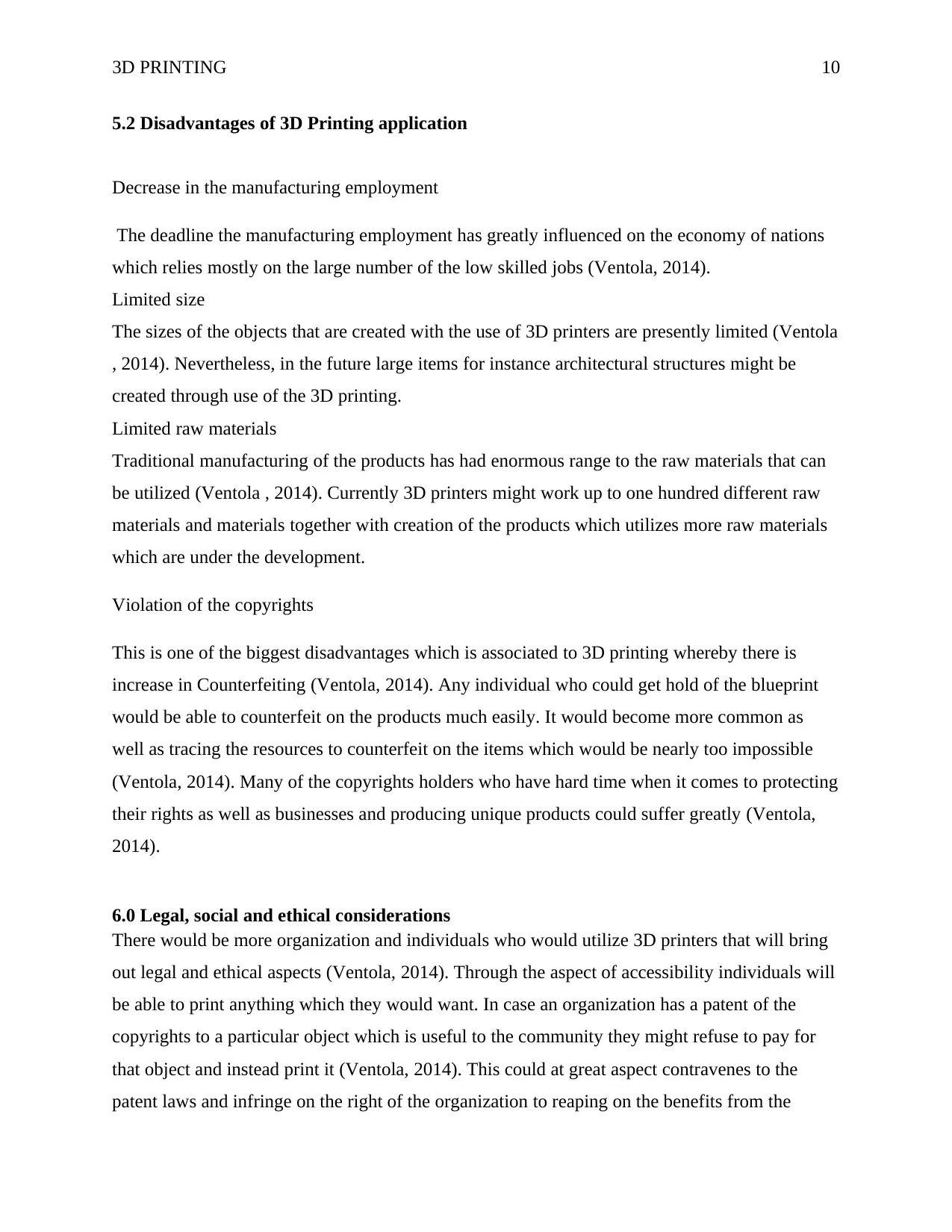
3D PRINTING 10
5.2 Disadvantages of 3D Printing application
Decrease in the manufacturing employment
The deadline the manufacturing employment has greatly influenced on the economy of nations
which relies mostly on the large number of the low skilled jobs (Ventola, 2014).
Limited size
The sizes of the objects that are created with the use of 3D printers are presently limited (Ventola
, 2014). Nevertheless, in the future large items for instance architectural structures might be
created through use of the 3D printing.
Limited raw materials
Traditional manufacturing of the products has had enormous range to the raw materials that can
be utilized (Ventola , 2014). Currently 3D printers might work up to one hundred different raw
materials and materials together with creation of the products which utilizes more raw materials
which are under the development.
Violation of the copyrights
This is one of the biggest disadvantages which is associated to 3D printing whereby there is
increase in Counterfeiting (Ventola, 2014). Any individual who could get hold of the blueprint
would be able to counterfeit on the products much easily. It would become more common as
well as tracing the resources to counterfeit on the items which would be nearly too impossible
(Ventola, 2014). Many of the copyrights holders who have hard time when it comes to protecting
their rights as well as businesses and producing unique products could suffer greatly (Ventola,
2014).
6.0 Legal, social and ethical considerations
There would be more organization and individuals who would utilize 3D printers that will bring
out legal and ethical aspects (Ventola, 2014). Through the aspect of accessibility individuals will
be able to print anything which they would want. In case an organization has a patent of the
copyrights to a particular object which is useful to the community they might refuse to pay for
that object and instead print it (Ventola, 2014). This could at great aspect contravenes to the
patent laws and infringe on the right of the organization to reaping on the benefits from the
5.2 Disadvantages of 3D Printing application
Decrease in the manufacturing employment
The deadline the manufacturing employment has greatly influenced on the economy of nations
which relies mostly on the large number of the low skilled jobs (Ventola, 2014).
Limited size
The sizes of the objects that are created with the use of 3D printers are presently limited (Ventola
, 2014). Nevertheless, in the future large items for instance architectural structures might be
created through use of the 3D printing.
Limited raw materials
Traditional manufacturing of the products has had enormous range to the raw materials that can
be utilized (Ventola , 2014). Currently 3D printers might work up to one hundred different raw
materials and materials together with creation of the products which utilizes more raw materials
which are under the development.
Violation of the copyrights
This is one of the biggest disadvantages which is associated to 3D printing whereby there is
increase in Counterfeiting (Ventola, 2014). Any individual who could get hold of the blueprint
would be able to counterfeit on the products much easily. It would become more common as
well as tracing the resources to counterfeit on the items which would be nearly too impossible
(Ventola, 2014). Many of the copyrights holders who have hard time when it comes to protecting
their rights as well as businesses and producing unique products could suffer greatly (Ventola,
2014).
6.0 Legal, social and ethical considerations
There would be more organization and individuals who would utilize 3D printers that will bring
out legal and ethical aspects (Ventola, 2014). Through the aspect of accessibility individuals will
be able to print anything which they would want. In case an organization has a patent of the
copyrights to a particular object which is useful to the community they might refuse to pay for
that object and instead print it (Ventola, 2014). This could at great aspect contravenes to the
patent laws and infringe on the right of the organization to reaping on the benefits from the
Paraphrase This Document
Need a fresh take? Get an instant paraphrase of this document with our AI Paraphraser
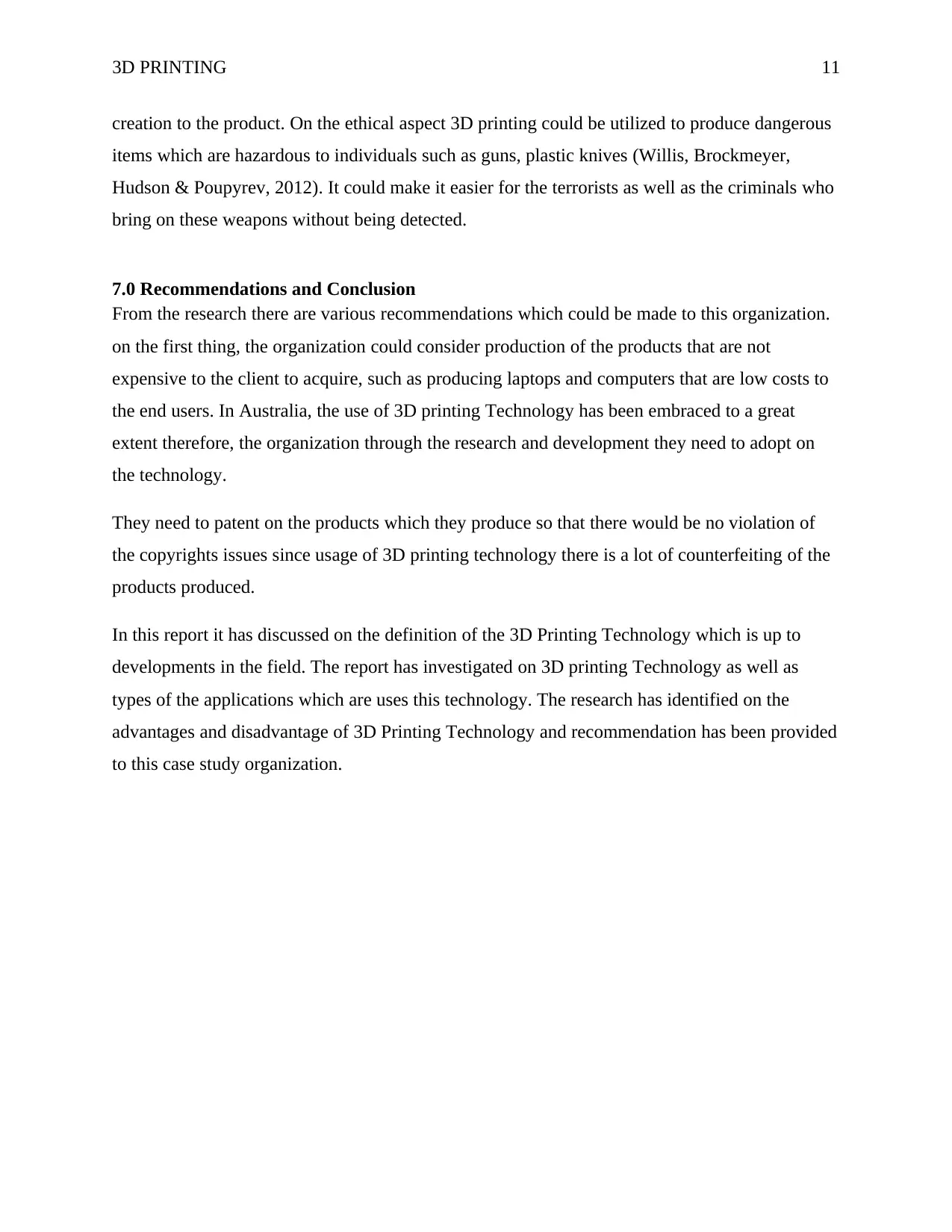
3D PRINTING 11
creation to the product. On the ethical aspect 3D printing could be utilized to produce dangerous
items which are hazardous to individuals such as guns, plastic knives (Willis, Brockmeyer,
Hudson & Poupyrev, 2012). It could make it easier for the terrorists as well as the criminals who
bring on these weapons without being detected.
7.0 Recommendations and Conclusion
From the research there are various recommendations which could be made to this organization.
on the first thing, the organization could consider production of the products that are not
expensive to the client to acquire, such as producing laptops and computers that are low costs to
the end users. In Australia, the use of 3D printing Technology has been embraced to a great
extent therefore, the organization through the research and development they need to adopt on
the technology.
They need to patent on the products which they produce so that there would be no violation of
the copyrights issues since usage of 3D printing technology there is a lot of counterfeiting of the
products produced.
In this report it has discussed on the definition of the 3D Printing Technology which is up to
developments in the field. The report has investigated on 3D printing Technology as well as
types of the applications which are uses this technology. The research has identified on the
advantages and disadvantage of 3D Printing Technology and recommendation has been provided
to this case study organization.
creation to the product. On the ethical aspect 3D printing could be utilized to produce dangerous
items which are hazardous to individuals such as guns, plastic knives (Willis, Brockmeyer,
Hudson & Poupyrev, 2012). It could make it easier for the terrorists as well as the criminals who
bring on these weapons without being detected.
7.0 Recommendations and Conclusion
From the research there are various recommendations which could be made to this organization.
on the first thing, the organization could consider production of the products that are not
expensive to the client to acquire, such as producing laptops and computers that are low costs to
the end users. In Australia, the use of 3D printing Technology has been embraced to a great
extent therefore, the organization through the research and development they need to adopt on
the technology.
They need to patent on the products which they produce so that there would be no violation of
the copyrights issues since usage of 3D printing technology there is a lot of counterfeiting of the
products produced.
In this report it has discussed on the definition of the 3D Printing Technology which is up to
developments in the field. The report has investigated on 3D printing Technology as well as
types of the applications which are uses this technology. The research has identified on the
advantages and disadvantage of 3D Printing Technology and recommendation has been provided
to this case study organization.
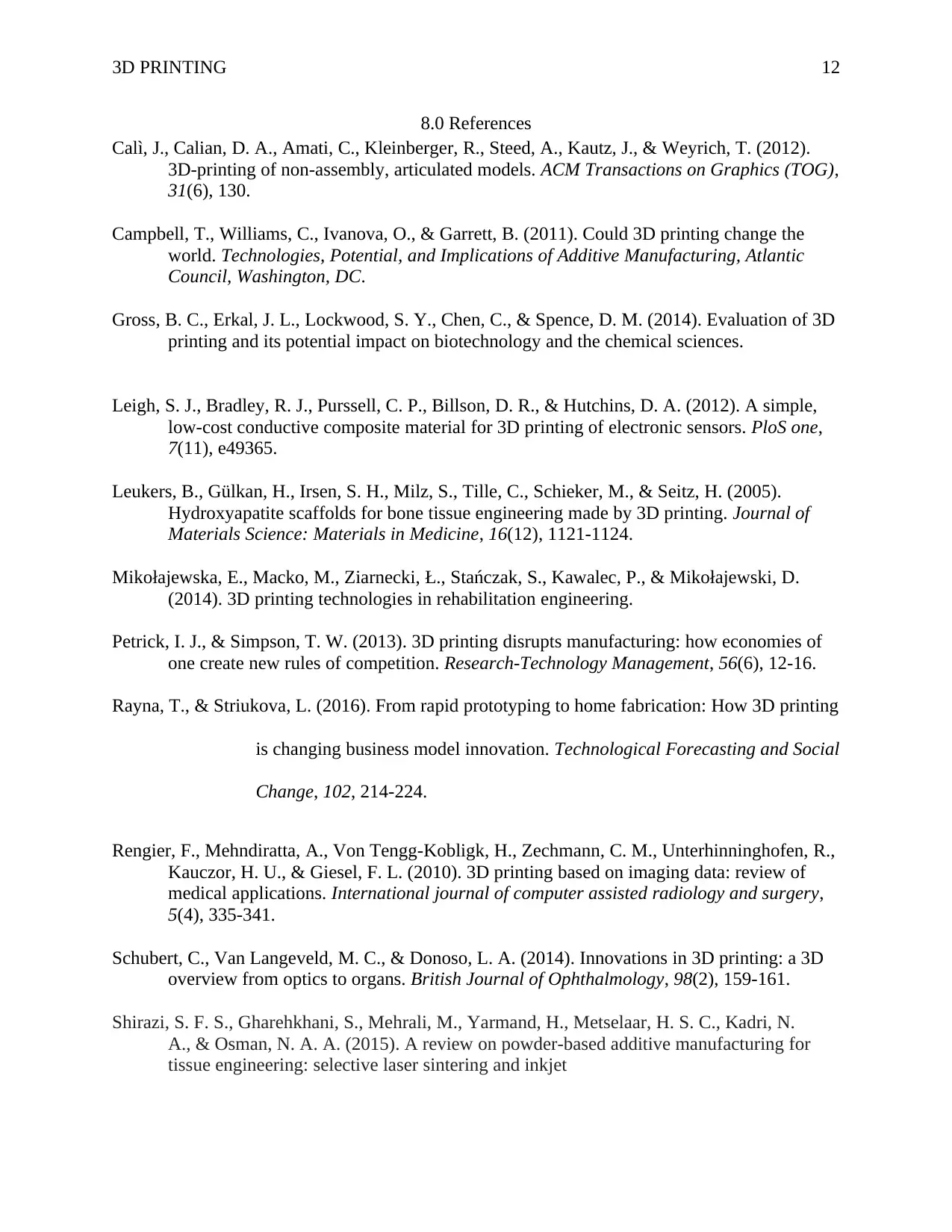
3D PRINTING 12
8.0 References
Calì, J., Calian, D. A., Amati, C., Kleinberger, R., Steed, A., Kautz, J., & Weyrich, T. (2012).
3D-printing of non-assembly, articulated models. ACM Transactions on Graphics (TOG),
31(6), 130.
Campbell, T., Williams, C., Ivanova, O., & Garrett, B. (2011). Could 3D printing change the
world. Technologies, Potential, and Implications of Additive Manufacturing, Atlantic
Council, Washington, DC.
Gross, B. C., Erkal, J. L., Lockwood, S. Y., Chen, C., & Spence, D. M. (2014). Evaluation of 3D
printing and its potential impact on biotechnology and the chemical sciences.
Leigh, S. J., Bradley, R. J., Purssell, C. P., Billson, D. R., & Hutchins, D. A. (2012). A simple,
low-cost conductive composite material for 3D printing of electronic sensors. PloS one,
7(11), e49365.
Leukers, B., Gülkan, H., Irsen, S. H., Milz, S., Tille, C., Schieker, M., & Seitz, H. (2005).
Hydroxyapatite scaffolds for bone tissue engineering made by 3D printing. Journal of
Materials Science: Materials in Medicine, 16(12), 1121-1124.
Mikołajewska, E., Macko, M., Ziarnecki, Ł., Stańczak, S., Kawalec, P., & Mikołajewski, D.
(2014). 3D printing technologies in rehabilitation engineering.
Petrick, I. J., & Simpson, T. W. (2013). 3D printing disrupts manufacturing: how economies of
one create new rules of competition. Research-Technology Management, 56(6), 12-16.
Rayna, T., & Striukova, L. (2016). From rapid prototyping to home fabrication: How 3D printing
is changing business model innovation. Technological Forecasting and Social
Change, 102, 214-224.
Rengier, F., Mehndiratta, A., Von Tengg-Kobligk, H., Zechmann, C. M., Unterhinninghofen, R.,
Kauczor, H. U., & Giesel, F. L. (2010). 3D printing based on imaging data: review of
medical applications. International journal of computer assisted radiology and surgery,
5(4), 335-341.
Schubert, C., Van Langeveld, M. C., & Donoso, L. A. (2014). Innovations in 3D printing: a 3D
overview from optics to organs. British Journal of Ophthalmology, 98(2), 159-161.
Shirazi, S. F. S., Gharehkhani, S., Mehrali, M., Yarmand, H., Metselaar, H. S. C., Kadri, N.
A., & Osman, N. A. A. (2015). A review on powder-based additive manufacturing for
tissue engineering: selective laser sintering and inkjet
8.0 References
Calì, J., Calian, D. A., Amati, C., Kleinberger, R., Steed, A., Kautz, J., & Weyrich, T. (2012).
3D-printing of non-assembly, articulated models. ACM Transactions on Graphics (TOG),
31(6), 130.
Campbell, T., Williams, C., Ivanova, O., & Garrett, B. (2011). Could 3D printing change the
world. Technologies, Potential, and Implications of Additive Manufacturing, Atlantic
Council, Washington, DC.
Gross, B. C., Erkal, J. L., Lockwood, S. Y., Chen, C., & Spence, D. M. (2014). Evaluation of 3D
printing and its potential impact on biotechnology and the chemical sciences.
Leigh, S. J., Bradley, R. J., Purssell, C. P., Billson, D. R., & Hutchins, D. A. (2012). A simple,
low-cost conductive composite material for 3D printing of electronic sensors. PloS one,
7(11), e49365.
Leukers, B., Gülkan, H., Irsen, S. H., Milz, S., Tille, C., Schieker, M., & Seitz, H. (2005).
Hydroxyapatite scaffolds for bone tissue engineering made by 3D printing. Journal of
Materials Science: Materials in Medicine, 16(12), 1121-1124.
Mikołajewska, E., Macko, M., Ziarnecki, Ł., Stańczak, S., Kawalec, P., & Mikołajewski, D.
(2014). 3D printing technologies in rehabilitation engineering.
Petrick, I. J., & Simpson, T. W. (2013). 3D printing disrupts manufacturing: how economies of
one create new rules of competition. Research-Technology Management, 56(6), 12-16.
Rayna, T., & Striukova, L. (2016). From rapid prototyping to home fabrication: How 3D printing
is changing business model innovation. Technological Forecasting and Social
Change, 102, 214-224.
Rengier, F., Mehndiratta, A., Von Tengg-Kobligk, H., Zechmann, C. M., Unterhinninghofen, R.,
Kauczor, H. U., & Giesel, F. L. (2010). 3D printing based on imaging data: review of
medical applications. International journal of computer assisted radiology and surgery,
5(4), 335-341.
Schubert, C., Van Langeveld, M. C., & Donoso, L. A. (2014). Innovations in 3D printing: a 3D
overview from optics to organs. British Journal of Ophthalmology, 98(2), 159-161.
Shirazi, S. F. S., Gharehkhani, S., Mehrali, M., Yarmand, H., Metselaar, H. S. C., Kadri, N.
A., & Osman, N. A. A. (2015). A review on powder-based additive manufacturing for
tissue engineering: selective laser sintering and inkjet
⊘ This is a preview!⊘
Do you want full access?
Subscribe today to unlock all pages.

Trusted by 1+ million students worldwide
1 out of 13
Related Documents
Your All-in-One AI-Powered Toolkit for Academic Success.
+13062052269
info@desklib.com
Available 24*7 on WhatsApp / Email
![[object Object]](/_next/static/media/star-bottom.7253800d.svg)
Unlock your academic potential
Copyright © 2020–2025 A2Z Services. All Rights Reserved. Developed and managed by ZUCOL.




